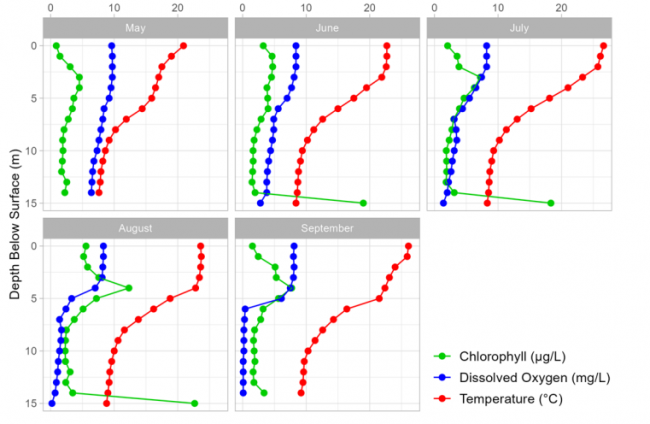
May – LEA’s water testing team collected the first fluorometer profile in late May. At that time, Sand Pond was already stratified. In the upper waters, fluorescence increased with depth until 3-4 meters. Below that, fluorescence gradually decreased and remained fairly uniform.
June – In the upper waters, fluorescence values increased slightly with depth but no obvious peak was noted. Fluorescence values remained uniform throughout the middle and deeper waters. Increased fluorescence values near the bottom are likely caused by interference from bottom sediments.
July – Warm surface waters provided algae favorable growing conditions, noted by the elevated fluorescence readings in the upper waters. Fluorescence values increased until reaching their peak at 3 meters. This is likely where the colder, denser water provided algae a place to “sit”. In the middle waters fluorescence values gradually decreased and then remained uniform throughout the deep waters. The spike in values at the bottom was again likely caused by sediment interference.
August – Warm surface waters again provided algae favorable growing conditions, noted by the elevated fluorescence readings in the upper waters. Fluorescence values increased until reaching their peak at 4 meters. This is likely where the colder, denser water provided algae a place to “sit”. In the middle waters fluorescence values gradually decreased and then remained uniform throughout the deep waters. The spike in values at the bottom was again likely caused by sediment interference.
September – In the upper waters, fluorescence values gradually increased until reaching their peak again at 4 meters. Below this peak, fluorescence values quickly decline to low levels and oxygen reaches near zero values. Synopsis: Algae concentrations were low to moderate throughout season. Peak algae growth was seen between 3 and 4 meters in depth with July, August, and September being the most productive months. High readings in the bottom waters were likely caused by sediment interference.

Gloeotrichia echinulata (a type of cyanobacteria (blue-green algae) commonly found in low-nutrient waters) can be seen with the naked eye. Gloeo density is reported as a value ranging from 0 – 6, based on the number of Gloeo colonies seen through a Secchi scope. Higher values indicate more Gloeo colonies. Gloeotrichia echenulata colonies were not observed in Sand Pond in 2023.

